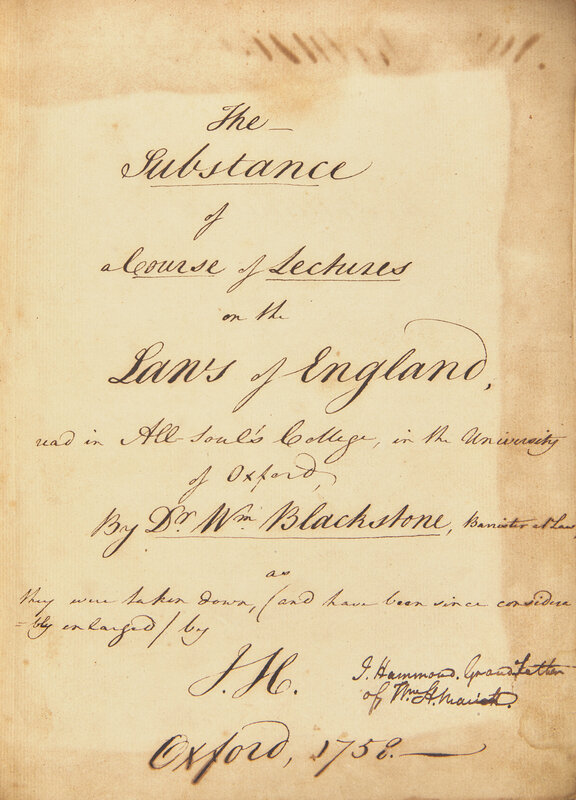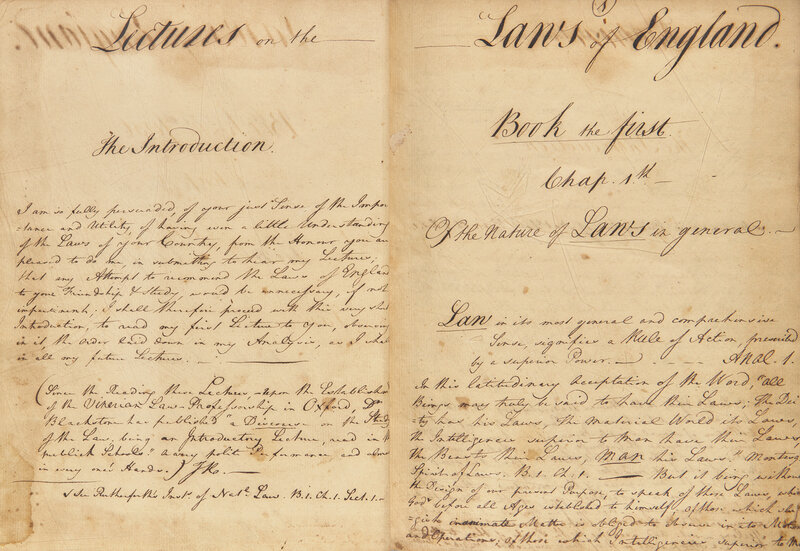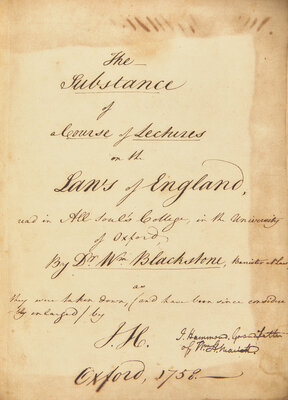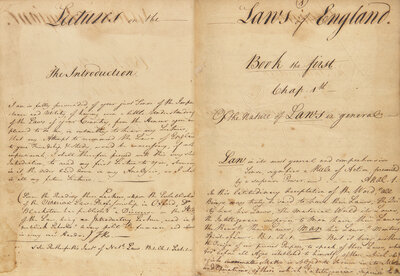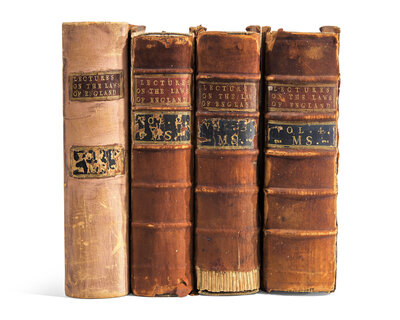Condition Report
Contact Information
Auction Specialist
Lot 21
[Blackstone, William] Contemporary Manuscript Lecture Notes From William Blackstone's Courses on the Laws of England
Sale 6308 - Printed and Manuscript Americana
Jan 29, 2025
10:00AM ET
Live / Philadelphia
Own a similar item?
Estimate
$15,000 -
25,000
Price Realized
$19,200
Sold prices are inclusive of Buyer’s Premium
Lot Description
[Blackstone, William] Hammond, John. Contemporary Manuscript Lecture Notes
Extensive Contemporary Lecture Notes from William Blackstone's Oxford Courses on English Law, Compiled by an Attending American-Born Law Student and Later Colonial Maryland Lawyer and Legislator
(University of Oxford), ca. 1758. In four volumes. Thick 8vo. (ii), 455; (483); (466); (582) ff. Manuscript notes, in the hand of Maryland-born Oxford student John Hammond, executed primarily on rectos (scattered manuscript, notations, and references on versos, by Hammond). Fair copy, compiled by Hammond likely from either his own rough or short-hand notes, and/or other sources. Full contemporary reverse tan calf, decorated in black, red and blue morocco spine labels, lettered in gilt; first volume rebacked; front board of second volume detached but holding, rear board of same detached; boards of third and fourth volumes starting; scattered spotting and soiling to text; light dampstaining and soiling in bottom edges of most leaves in second through fourth volumes; ownership inscription of William Hammond Marriot (John's grandson) on title-page of first volume, and signed by Marriot on front paste-downs of other volumes. First volume foliated at top by Hammond, with some numbers partially or fully trimmed away; other volumes not foliated.
A very rare and extensive set of contemporary lecture notes from William Blackstone's 1758 course on English common law at the University of Oxford, created by John Hammond (1735-80), an American-born Oxford law student.
Possibly the only surviving lecture notes of this kind created by an American, they comprise over 2,000 pages, and provide a significant glimpse into Blackstone's groundbreaking legal pedagogy--the influence of which would have a profound effect on the Revolutionary generation of America (of which Hammond was a part), and beyond, and that would help lay the foundation for American jurisprudence.
Hammond was one of about only 50 American-born lawyers who were educated in England prior to 1760 (Warren, History of the American Bar, 1911, p. 180). Admitted to the Middle Temple in February 1753, he studied the law alongside several Americans who would become leaders during the American Revolution--and in American politics and law more generally--such as John Dickinson, John Banister, John Blair, John Rutledge, Jr., Joseph Reed, and Thomas McKean, among others. In January 1758, at age 23, Hammond matriculated to Oriel College at Oxford, and shortly after compiled these notes, from his attendance of Blackstone's seminal courses on the common law of England at All Soul's College, at the University of Oxford.
Hammond's notes are comprehensive, and methodically follow the framework established by Blackstone in his Analysis of the Laws of England, a synopsis of English common law first published in 1756 as a teaching aid for students attending his lectures (itself an outgrowth of Blackstone’s novel printed diagrammatical course syllabi created for his first common law lecture in 1753). The clarity and ingenuity of Blackstone's instruction is reflected in these lecture notes, which are primarily a transcription of Blackstone's lecture speeches, with Hammond's own opinions sometimes interspersed. Blackstone's lectures (and his published works) for the first time organized into an orderly and logical system the messy collection of principles and decisions that constituted English common law. They would serve as the basis for his magnum opus, Commentaries on the Laws of England, published in four volumes between 1765-69--which would become a bestseller and highly influential work upon its publication in America in 1771-72.
Blackstone's work provided the foundation for legal education in America, and crucially, offered Hammond and his American contemporaries a succinct guide to the English legal tradition, which would come to help them define their own positions in the developing imperial crisis in the following two decades, and beyond. For American law students, "It was the advent of Blackstone which opened the eyes…to the broader field of learning in the law. He taught them, for the first time, the continuity, the unity, and the reason of the Common Law--and just at a time when the need of a unified system both in law and in politics was beginning to be felt in the Colonies." (Warren, p. 177)
In February 1760, Hammond was admitted to the English bar, and later that same year returned to his home in Anne Arundel County, Maryland, where he began a career in law and politics. He was admitted to the courts of Anne Arundel and Frederick Counties, as well as the Provincial and Chancery courts, and succeeded his deceased father in the Lower House of Maryland's General Assembly, representing Anne Arundel County. It was during this same time that he taught law to Founding Father, future Signer of the Declaration of Independence, and Supreme Court Justice, Samuel Chase. Hammond's entrance into Maryland's judicial community during this time coincided with the beginnings of the imperial crisis between the American colonies and the English Crown, his term in office occurring during the passage and protest of the hated Stamp Act. "In no Province was there greater excitement over the Stamp Act or greater struggle against the assertion of arbitrary legislative powers by the Royal Governors. To deal with these conditions the pre-Revolutionary Bar was brilliantly fitted." (Warren, p. 55). At this time Hammond served on a critical committee that drafted instructions to Maryland's delegates to the Stamp Act Congress. He served in the Assembly until 1771, afterwards continuing his successful law practice in Annapolis, until his death from an illness in 1780, age 45.
This manuscript comprises the first three books laid out in Blackstone's Analysis, covering his topics on the rights of persons (first volume), the rights of things (property rights, second and third volumes), and private wrongs (torts or civil wrongs, fourth volume). The fourth and final volume of the Analysis on public wrongs (criminal law) is not present. The title-page of the first volume reads, "The Substance of a Course of Lectures on the Laws of England, read in All Soul's College, in the University of Oxford, By Dr. Wm. Blackstone, Barrister at Law, as they were taken down, (and have been since considerably enlarged), by J.H. Oxford, 1758." A parenthetical note by Hammond at the start of the first volume states, "Since the Reading these Lectures,--Upon the Establishmt. of the Vinerian Law-Professorship in Oxford, Dr. Blackstone has published 'a Discourse on the Study of the Law; being an Introductory Lecture, read in the publick Schools.' A very polite Performance and almost in every one's Hands."
John Hammond was born into a wealthy and powerful colonial Maryland family, and was the second son of the esteemed Col. Philip Hammond (1697-1760), a prominent planter and merchant, who served in the Lower House of Maryland's Colonial Assembly, representing Anne Arundel County, from 1732-60, and was House Speaker from 1740-41. John's brothers, Rezin (1745-1809) and Matthias (1740-86), led the radical faction in Anne Arundel County, where they agitated for American independence during the 1770s. During the Revolution they served in the Anne Arundel County Militia, as well as on the Annapolis Committee of Safety and Committee of Correspondence. In 1776, Rezin sat in the Maryland Constitutional Convention, where he advocated for universal male suffrage. John married Henrietta Dorsey (b. ca. 1755), and had six children.
Contemporary lecture notes from William Blackstone's lectures are very rare, and seldom come to market. RBH notes only two others at auction since 1967: J. Mourdant's, six volumes, ca. 1753-54 (Sotheby's, July 17, 1967, lot 500) and Rev. William Sandys', 132 pp. (Bloomsbury, March 18, 2004, lot 46). For other contemporary lecture notes, see Wilfrid Prest, Blackstone's Magna Carta, p. 1512, and note 102, pp. 1512-1513 (in North Carolina Law Review, Vol. 94, No. 5, June 1, 2016) and his William Blackstone: Law and Letters in the Eighteenth Century, pp. 115-116 (2008): locating 11 examples of varying length, dated from 1753-67, with most authors unidentified.
The current manuscript has descended in John Hammond's family, and has never been offered for sale.
This lot is located in Philadelphia.
